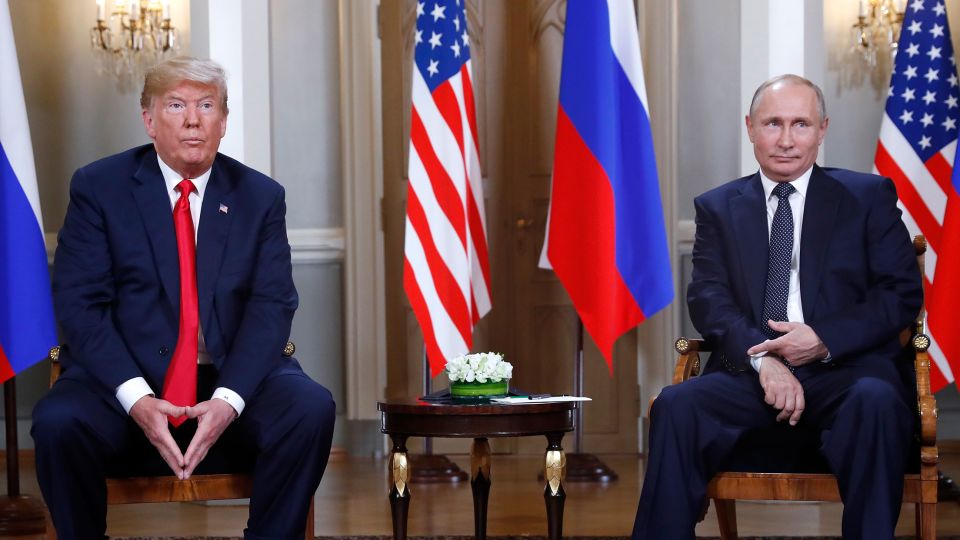President Donald Trump said he’ll be meeting with Russian President Vladimir Putin next Friday in Alaska after earlier in the day previewing terms of a potential peace deal to end the war in Ukraine that could include “some swapping of territories.”
“The highly anticipated meeting between myself, as President of the United States of America, and President Vladimir Putin, of Russia, will take place next Friday, August 15, 2025, in the Great State of Alaska. Further details to follow,” Trump posted on Truth Social Friday evening.
Ukraine’s President Volodymyr Zelensky quashed the idea of any territory formally changing hands. In a video address after Trump’s announcement, he said Ukraine is “also ready to work together with President Trump,” but vowed his people “will not give their land to the occupier.”
Trump’s announcement — which comes on the day he had set as the deadline for Putin to make peace or face severe economic punishment — marks a major moment in the US president’s relationship with his Russian counterpart, who hasn’t been to the US since 2015 and hasn’t met with Trump since 2019.
US officials, including Trump, have briefed European leaders and Ukrainian officials on a plan offered by Putin to halt the war in Ukraine in exchange for significant territorial concessions by Kyiv, according to Western officials briefed on the matter.
The plan, which Putin presented to Trump’s foreign envoy Steve Witkoff in a meeting in Moscow on Wednesday, would require Ukraine to cede the eastern Donbas region — the majority of which is currently occupied by Russia — as well as Crimea, which Russia illegally annexed in 2014.
The plan would freeze current battle lines, but other details of the proposal were still unclear.
It alarmed some European officials, who voiced concern it was Putin’s attempt to avoid Trump’s threatened sanctions, which were supposed to come due Friday, while offering little in return.
But the plan appeared to be the impetus for which Trump put in motion plans for a summit meeting with Putin. The Russian leader hasn’t been to the US in nearly a decade, when he met with then-President Barack Obama at a UN General Assembly meeting in September 2015.
In his statement after Trump’s announcement, Zelensky said: “Any decisions that are against us, any decisions that are without Ukraine, are also decisions against peace.
“These are dead solutions. They will never work. And we all need a real, living peace that people will respect.”
The Kremlin’s Presidential Aide Yury Ushakov confirmed the meeting in Alaska, adding that it “seems quite logical” for such an important summit to take place in Alaska with the Russian delegation simply flying over the Bering Strait and the two countries’ maritime border.
Ushakov revealed Russia has already invited Trump for a follow-up meeting in Russia.
Ukrainian servicemen fire a M777 howitzer towards Russian positions at the frontline in Ukraine’s Zaporizhzhia region on Thursday. – Evgeniy Maloletka/AP
Additional calls with the Europeans have occurred over the past two days, including with Witkoff and Secretary of State Marco Rubio. Witkoff spoke with several European officials on Friday to lay out additional details of the plan.
It wasn’t clear what the plan would mean for two other regions in Ukraine — Zaporizhzhia and Kherson — where Russia controls some territory, beyond Russia stopping its offensive there.
Nor was it clear how Putin’s proposal would address the Russian leader’s other demands for ending the war, including a pledge that Ukraine never join NATO or that it limit the size of its military.
In his conversations, Witkoff has told European officials that the proposal put forward by Putin was a step in the right direction, and that a larger peace plan could be negotiated once the fighting is stopped.
The United States has been trying to get allies to agree to this plan, one source said, though it’s still unclear that will happen.
The possibility of Russia taking control of Donetsk and Luhansk in a ceasefire deal has raised some concern over whether such an agreement would just encourage Russia to attack Ukraine again down the road.
“Official recognition of territory conquered by force without a cost is an incentive to do more in the future,” one European official briefed on the topic said. “It could incentivize Russia to do more attacks on Ukraine again in a few years.”
Trump, who’d acknowledged frustration with Russia’s president in recent months for drawing out the conflict, seemed more optimistic for the prospect of a peace deal Friday. And he signaled he’s focused primarily on negotiating an end to the hostilities as soon as possible.
“The European leaders want to see peace,” Trump told reporters at the White House before announcing the Alaska meeting. “President Putin, I believe, wants to see peace, and Zelensky wants to see peace.”
He later added: “My instinct really tells me that we have a shot at” peace.

Ukrainian President Volodymyr Zelensky, pictured in Rome, Italy, on July 10. – Antonio Masiello/Getty Images/File
But the prospect of Ukraine ceding any of its territory to Russia could prove a major stumbling block in negotiating an end to the war. Such concessions are against the Ukrainian constitution, meaning Zelensky would need to first get permission from parliament or a national referendum before agreeing to any shift in territory.
Trump on Friday downplayed those concerns, saying he’d urged Zelensky to smooth the path toward an agreement.
“He’s going out and getting what he needs,” Trump said. “He’s not authorized to do certain things. I said, ‘Well, you’re going to have to get it fast, because, you know, we’re getting very close to a deal.’”
Earlier this week, Trump pledged he’d apply new sanctions on Russia if Putin didn’t end the war in Ukraine by Friday, but he struck a less hardline tone on Thursday, telling reporters in the Oval Office, “It’s going to be up to (Putin)” if the Friday deadline would hold.
Pressed by CNN’s Kaitlan Collins Thursday if Putin would have to meet with Zelensky as a prerequisite for a face-to-face meeting between Trump and Putin, Trump said, “No, he doesn’t.”
Trump and Putin met face-to-face six times during the US president’s first term in office – largely at G20 summits and APEC meetings.
Their high-profile summit in July 2018 in Helsinki, Finland, when Trump sided with Putin over US intelligence agencies, was one of the most controversial moments of Trump’s first term and sparked days of White House clean up.
The last time Putin met with a United States president was June 2021, in Geneva, Switzerland, where he met with then-President Joe Biden.
CNN’s Kit Maher, Samantha Waldenberg and Jeff Zeleny contributed to this report.
This story has been updated with additional developments.
For more CNN news and newsletters create an account at CNN.com

